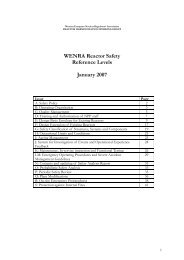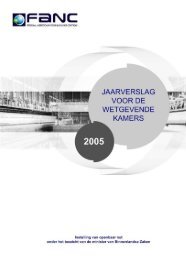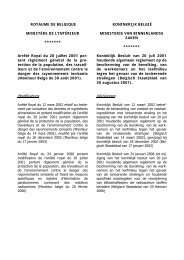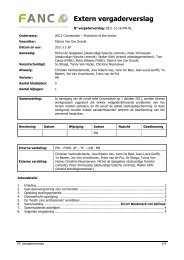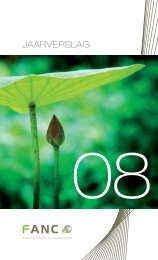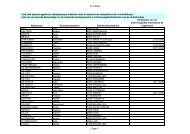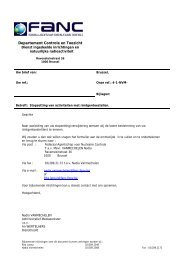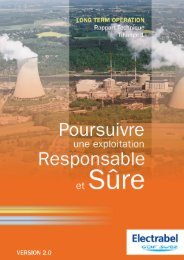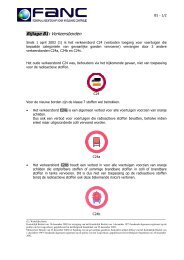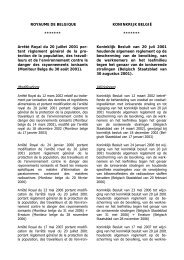report
report
report
- No tags were found...
You also want an ePaper? Increase the reach of your titles
YUMPU automatically turns print PDFs into web optimized ePapers that Google loves.
1. IntroductionBelgium has always been a pioneering country in the development of nuclear sciences andtechnologies for peaceful purposes. As such, the country is endowed with seven pressurized waterreactors currently in operation on two distinct sites:• The Doel site, located on the Scheldt river close to Antwerp (Flanders), home of four reactors:o Doel 1/2: twin units of 433 MWe each, commissioned in 1975,o Doel 3: single unit of 1 006 MWe, commissioned in 1982,o Doel 4: single unit of 1 039 MWe, commissioned in 1985.• The Tihange site, located on the Meuse river close to Liège (Wallonia), home of threereactors:o Tihange 1: single unit of 962 MWe, commissioned in 1975,o Tihange 2: single unit of 1 008 MWe, commissioned in 1983,o Tihange 3: single unit of 1 054 MWe, commissioned in 1985.Both sites are operated by the same licensee, namely Electrabel, a company of the GDF-SUEZ energyand services Group.For all nuclear safety related matters, the licensee’s activities are under the control of the Belgianregulatory body 1 , which is composed of:• the Federal Agency for Nuclear Control (FANC),• and Bel V, its technical subsidiary.As a consequence of the accident that occurred on 11 March 2011 at the Japanese Fukushima-Daiichinuclear power plant, a wide-scale targeted safety reassessment program was set up among themember states of the European Union operating nuclear power plants.This “stress tests” program is designed to re-evaluate the safety margins of the European nuclearpower plants when faced with extreme natural events (earthquake, flooding and extreme weatherconditions) and their potential consequences (loss of electrical power and loss of ultimate heat sink),and to take relevant action wherever needed. The approach is meant to be essentially deterministic,focusing not only on the preventive measures but also on the mitigative measures (severe accidentmanagement).The scope of the Belgian stress tests covers all seven reactor units including the associated spent fuelpools, and the dedicated spent fuel storage facilities at both sites, namely:• “SCG” building at Doel (dry cask spent fuel storage facility),• “DE” building at Tihange (wet spent fuel storage facility).In accordance with the European methodology, the stress tests of the nuclear power plants areperformed in three phases:1. The licensee carries out the stress tests in its facilities and communicates a final <strong>report</strong> to theBelgian regulatory body (in the present case, one final <strong>report</strong> per site). In these <strong>report</strong>s, thelicensee describes the reaction of the facilities when facing the different extreme scenarios,and indicates, where appropriate, the improvements that could be implemented to reinforcesafety. This phase was achieved by the licensee on 31 October 2011.2. The regulatory body reviews the licensee’s final <strong>report</strong>s and evaluates the approach and theresults. Based on these data, the regulatory body writes its own national <strong>report</strong> andcommunicates it to the European Commission. This phase was achieved by the regulatorybody on 30 December 2011.1 Additional information about the Belgian regulatory body and nuclear facilities is available on the FANC website(http://www.fanc.fgov.be), specifically in the 2010 <strong>report</strong> for the Convention on Nuclear Safety3/18



